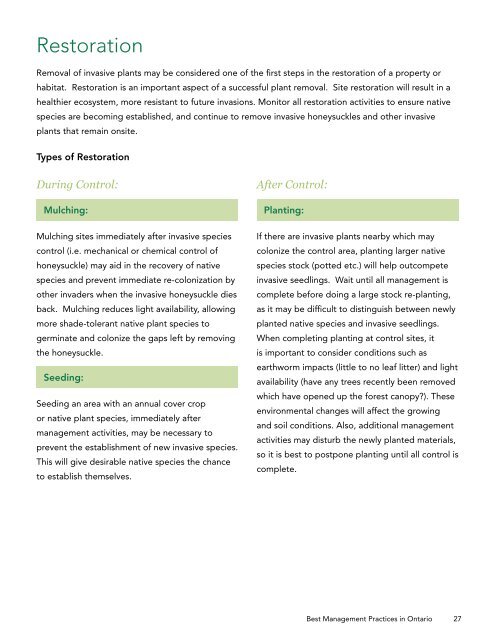OIPC_BMP_Honeysuckle_Feb182014_FINAL2
OIPC_BMP_Honeysuckle_Feb182014_FINAL2
OIPC_BMP_Honeysuckle_Feb182014_FINAL2
You also want an ePaper? Increase the reach of your titles
YUMPU automatically turns print PDFs into web optimized ePapers that Google loves.
Restoration<br />
Removal of invasive plants may be considered one of the first steps in the restoration of a property or<br />
habitat. Restoration is an important aspect of a successful plant removal. Site restoration will result in a<br />
healthier ecosystem, more resistant to future invasions. Monitor all restoration activities to ensure native<br />
species are becoming established, and continue to remove invasive honeysuckles and other invasive<br />
plants that remain onsite.<br />
Types of Restoration<br />
During Control:<br />
Mulching:<br />
Mulching sites immediately after invasive species<br />
control (i.e. mechanical or chemical control of<br />
honeysuckle) may aid in the recovery of native<br />
species and prevent immediate re-colonization by<br />
other invaders when the invasive honeysuckle dies<br />
back. Mulching reduces light availability, allowing<br />
more shade-tolerant native plant species to<br />
germinate and colonize the gaps left by removing<br />
the honeysuckle.<br />
Seeding:<br />
Seeding an area with an annual cover crop<br />
or native plant species, immediately after<br />
management activities, may be necessary to<br />
prevent the establishment of new invasive species.<br />
This will give desirable native species the chance<br />
to establish themselves.<br />
After Control:<br />
Planting:<br />
If there are invasive plants nearby which may<br />
colonize the control area, planting larger native<br />
species stock (potted etc.) will help outcompete<br />
invasive seedlings. Wait until all management is<br />
complete before doing a large stock re-planting,<br />
as it may be difficult to distinguish between newly<br />
planted native species and invasive seedlings.<br />
When completing planting at control sites, it<br />
is important to consider conditions such as<br />
earthworm impacts (little to no leaf litter) and light<br />
availability (have any trees recently been removed<br />
which have opened up the forest canopy). These<br />
environmental changes will affect the growing<br />
and soil conditions. Also, additional management<br />
activities may disturb the newly planted materials,<br />
so it is best to postpone planting until all control is<br />
complete.<br />
Best Management Practices in Ontario<br />
27



